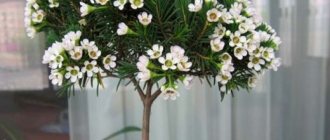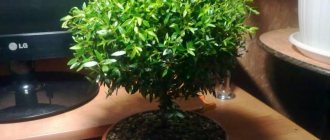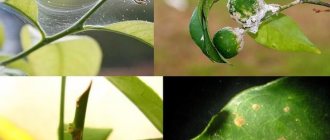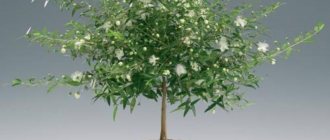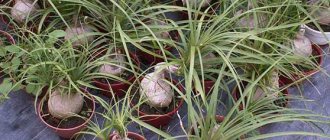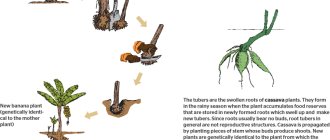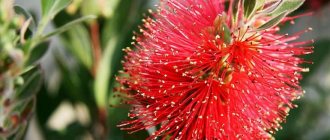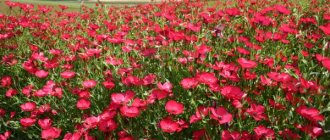The myrtle tree is a plant about which there are many legends that explain its appearance on earth. One of them says: when expelled from paradise, Adam took a myrtle twig to earth and grew a myrtle tree from it, which reminded him of the Garden of Eden.
What is myrtle? The plant received its name due to the high content of essential oils, the meaning of the Greek word “myrtle” is “balm” or “incense”.
Myrtle is a tree or shrub, distinguished by its graceful form and amazing aroma, which arouse great interest among flower growers and admirers of the art of bonsai.
Wintering in the open ground is possible only in warm regions, which is why the indoor myrtle flower is cultivated in Russia.
Origin and appearance of the myrtle tree
The Mediterranean region is considered to be the birthplace of myrtle (Myrtus). It belongs to the Myrtaceae family.
Its wild varieties grow in Italy, France, Spain, Greece, and North Africa. The plant can be found in the countries of the American continent, Australia, Asia, and the Azores.
Myrtle tree grown in bonsai style
The plant is a representative of the flora of slow development - annual growth does not exceed 15 cm.
In the wild, this tree is up to 5 meters high. Myrtle as a house flower usually grows up to 60 cm, less often reaching 1 meter in height.
Myrtle is an evergreen plant with entire, opposite leaves of emerald color with small veins containing essential oil with a wonderful aroma.
White flowers, collected in short racemes of inflorescences, can form bunches or grow solitary.
In place of the flowers, round fruits appear in the fall, usually dark blue in color. Sometimes the fruits are yellowish and whitish tones. Inside there are irregularly shaped seeds from which you can grow a new tree.
The tenderness of the flower causes amazement
A small flower with five snow-white petals and golden stamens has an incredible aroma.
Characteristics of culture
- It belongs to the genus of evergreen woody plants. Myrtle is great for bonsai.
- Flower/fruit color: Flowers can be of different shades: white, pink or cream. The fruit is a small black berry.
- Leaf color: The foliage is dark green, the leaves are oval in shape.
- Requirement for sun: The myrtle tree loves light very much, but does not tolerate direct sunlight.
- Size: In nature, the myrtle tree can grow up to 2 meters. At home, this flower grows no more than a meter.
- Flowering: Many stamens create an amazing visual effect, as if making the plant more delicate and weightless. With proper care, the tree is covered with flowers.
- Aroma: The fragrance of myrtle oil can be compared to an exquisite perfume. Slightly bitter, with a hint of eucalyptus. Fresh pleasant aroma.
Such a beautiful tree as myrtle looks very harmonious in any room. Growing it at home is not so difficult; the most important thing is to know all the nuances of this process. If treated correctly, myrtle will delight you with lush blooms and a pleasant aroma.
Types and varieties of myrtle tree
There are from 20 to 40 species and more than 100 varieties of myrtle. Most of them are grown in botanical gardens in many countries around the world.
Myrtle - care at home, how to reanimate if it has dried out
For growing at home, the variety most often used is the common myrtle, the most unpretentious of them.
The characteristics that attract the plant are its high decorative value, aroma, healing properties and the ability to grow a bonsai tree.
Swamp myrtle (Calyculata)
Swamp myrtle is an evergreen shrub up to 1 meter high. The popular name is Cassandra.
The crown is spreading, the stems are straight. There are small scales on the branches. The leaves are small, attached to short petioles. Snow-white flowers are collected in racemes. It is distinguished by its adaptability to the Russian frosty winter. The favorite place of growth is sphagnum bogs. Life expectancy is up to 50 years.
Additional Information. Leaves and shoots contain poison. Their use as livestock feed is strictly prohibited.
Variegata myrtle
It is distinguished by variegated leaves, bordered by specks and dashes of an amber hue, the brightness of which depends on the light. Myrtle variegata feels great outdoors and indoors.
When favorable conditions are created, it begins to bloom with small flowers of beige and snow-white shades with golden stamens. Used to make flower arrangements.
Unusual flower of the marsh myrtle
Exudes an amazing aroma, destroys germs and neutralizes carbon dioxide. Considered a symbol of fertility.
Myrtle Hymen
The evergreen shrub received its name in honor of the God of Marriage, the second name is the Happiness of the Bride. Symbolizes youth and beauty. Young people planning to become hymen gave each other branches of myrtle. It has small emerald-colored leaves in the shape of a lancet. In the wild it grows up to 5 meters tall, as a houseplant - no higher than 1 meter. Flowering branches decorate wedding bouquets.
Lush flowering of the Hymen variety
Lemon Myrtle (Lemon)
It has a lemon scent. In the wild it is found in the tropical zone of the Australian mainland. Widely used in cooking for the preparation of syrups, sauces, dressings and drinks. Dried leaves are used as spices and seasonings.
Myrtle Communis, or common (Communis)
Myrtle Communis belongs to the ornamental crops. Prevails in evergreen oak forests of the Mediterranean adjacent to thickets of shrubs. It looks like a small evergreen tree up to 5 meters high.
Interesting! The leaves are single, oblong in shape, located on tetrahedral stems. Blooms profusely with snow-white, very fragrant flowers located on short racemes.
Large-leaved myrtle
A variation of the common subspecies. Myrtle macrofolia has an antimicrobial effect. Destroys bacteria and pathogenic rods. Used in the treatment and prevention of:
- flu;
- tonsillitis;
- sinusitis;
- prostatitis;
- gastrointestinal diseases.
Grows up to 4 meters. The stems are tetrahedral, shiny leaves are opposite, up to 5 cm long with pointed edges. Small flowers with five snow-white petals grow on long stalks. The golden stamens are arranged symmetrically.
Myrtle Alhambra
Attracts with its decorative appearance. Suitable for growing outdoors and as a houseplant. Used to create compositions. Prefers bright, illuminated places.
White myrtle fruits Alhambra
Flowering occurs in spring. The snow-white flowers are miniature with a strong aroma. In their place, oval-shaped seed pods are formed; unlike other species, they are snow-white in color.
Myrtle Tarentina
Dwarf form of the common subspecies. It blooms profusely with miniature fragrant snow-white flowers collected in inflorescences.
Small-leaved, leaves no more than 1.5 cm in length, elongated in shape with sharp jagged edges, located on short emerald petioles.
This representative of the flora is growing rapidly. In the wild it exceeds 5 meters, in indoor conditions it reaches 1 meter. Responds well to sunlight, regular watering and spraying.
African myrtle (Myrsina)
African myrtle is mistakenly classified as a member of the Myrtaceae family, although it belongs to the Myrsinoideae family. They have an external similarity, but a closer look reveals a different shape of the leaves, the flowers are smaller and different from the myrtles.
The correct name for the lookalike is African myrsina. Habitat:
- African continent;
- China;
- Himalayas.
Myrsina Africana of the Myrsinaceae family
There are shrubby and tree-like forms of myrsina, and there are variegated ones that require good lighting.
The shoots are reddish. The small elliptical leaves are dark green on the upper side and light green on the lower side.
There are female and male flowers. The first ones are smaller with white, light purple or pinkish petals. Men's - in lilac tones with bright red anthers.
The purple berries produced in autumn are fleshy, ball-shaped and contain 1 seed. They hang on the branches for a long time, maintaining their decorative appearance.
Kinds
- Myrtle Common is exactly the plant whose various varieties we see in potted plants. Under natural conditions, it is a tree or woody shrub 3-4 m long with small opposite entire leaves 2-5 cm long and 1-2 cm wide. The flowers of this species are white and do not exceed 2 cm in diameter.
- Sahara myrtle is found in relict forests, small islands located almost in the center of the Sahara and is an endangered species.
- Myrtle Lush is distinguished by peeling brown bark, revealing whitish-cream wood underneath. The flowers are white, the berries are reddish-black and edible.
- Myrtle Hequen is the most resilient of the species. It is distinguished by shiny leaves with a wavy edge.
- Ralph's myrtle is a beautiful upright shrub with pink flowers and edible red fruits. There is a variety whose leaves are edged with a cream border.
Common Myrtle is the only species that grows indoors.
The only type of myrtle that is grown as a potted plant is Common Myrtle. But it has many varieties, and its characteristic feature is that even plants grown from cuttings of one bush can differ noticeably from each other.
Transplanting myrtle into a pot after purchasing
Store-bought myrtle requires special attention. Any change of environment causes stress. For myrtle, the right choice of environment is the main condition for growing.
Indoor plants that purify the air in the apartment
The plant is quarantined for two weeks to adapt to new conditions. At this time, it is necessary to treat possible pests with a complex pesticide.
Note! Spraying should be carried out in a non-residential, well-ventilated area, avoiding contact of the drug with food, animals and people.
An urgent transplant of a purchased flower is necessary for two reasons:
- Often the soil used to place the plant before sale does not meet the requirements and may contain harmful impurities.
- The myrtle was purchased in a shipping container unsuitable for flower development.
What is needed for planting
This plant does not like large pots; it must be moved to a pot that is the same size as the store-bought one, so that the root ball fills the entire internal space of the container.
Important! The size of the pot should match the myrtle root ball.
It is necessary to prepare the land for planting by correctly determining the composition and ratio of components. Slightly acidic soil suits it. You can use a store-bought evergreen mix or prepare your own mix.
There are several options for soil composition.
First:
- turf – 1 part;
- humus – 1 part;
- peat soil and sand in equal proportions - 1 part.
Second:
- sand – 1 part;
- humus - 2 parts;
- clay soil – 2 parts;
- turf - 2 parts.
Simple greenhouse soil will do.
You can add hydrogel to the myrtle soil; it will retain moisture. It is necessary to prepare material for drainage; it is recommended to use perlite and expanded clay.
Additional Information. The best effect is observed when perlite and vermiculite are mixed into the soil.
Optimal place
A window sill facing west or east would be a suitable place in the house. This arrangement will meet the lighting and temperature requirements.
Additional Information. Insufficient lighting will affect the appearance: elongated stems, faded small leaves. When there is too much light, the leaves turn yellow and curl.
Myrtle is not afraid of drafts; frequent ventilation will benefit it. To ensure a flow of fresh air, in the summer it is useful to move the myrtle to the balcony or garden, gradually accustoming it to the new place.
Step by step planting process
It is recommended to plant on the 2nd or 3rd day after watering, when the root ball has dried out (it is easier to remove it from the container).
Sequencing:
- Carefully remove the bush (tree) from the pot.
- If possible, clear the roots from the soil.
- Carefully trim off tangled and dry roots.
- Place a layer of drainage at the bottom of the pot.
- Sprinkle with prepared soil for myrtle in a layer of 2-3 cm.
- Place the seedling vertically.
- Fill the pot with the mixture, lightly compacting the soil around the trunk.
- Water thoroughly and remove excess water from the pan after a while.
Replanting - removing old soil, trimming dry roots
Important! The root collar should remain above ground level.
An adult plant is replanted every 3-4 years, choosing a larger pot; a young seedling is replanted annually.
In order not to damage the roots, they use the transshipment method: they are transplanted into another larger container along with the contained soil mixture, adding fresh substrate.
Benefits of myrtle essential oil
Essential oil is obtained not from wood, but from shoots along with leaves, which are crushed and then steam distilled. The myrtle herb is used to produce a thin, slightly orange oil.
The aroma of the ether is slightly bitter, similar to eucalyptus and cypress. It is worth noting that myrtle oil goes well with other oils and has many beneficial properties:
- It affects the activity of the nervous system, helping to calm down in a stressful situation, cope with fatigue, depression and insomnia. Common myrtle is an active aphrodisiac.
- It is an effective antiseptic and quickly deals with bacteria, so the action of myrtle is compared to medical antibiotics.
- It copes well with respiratory tract infections, so it can be used for inhalation.
- For massages, oil is added to the cream, taking into account that for 15 g. there should be 4-6 drops.
The fragrant and surprisingly calming myrtle - a symbol of glory, love unions, good deeds - was a sacred plant and very revered even before the era of Hellenistic culture, although the ancient Greeks glorified this plant and the oil extracted from its leaves.
It was they who first began to actively use myrtle oil for incense and associated the smell of this tree with impeccably glossy foliage and beautiful flowering with mythological legends.
We recommend reading: Description of medicinal valerian, medicinal properties, contraindications
In antiquity, myrtle was a symbol of the goddess Venus, and the very origin of the plant was associated with the sad legend of a beautiful nymph who died at the hands of the treacherous Athena, in whose honor the beautiful representatives of the trees were named.
During the Renaissance, myrtle was the main symbol of marital fidelity and eternal union; in Christian culture it was perceived as a symbol of hope, and in Arab culture it was perceived as a symbol of the Garden of Eden. Even the royal traditions of Britain are invariably associated with this plant, which is used in royal weddings.
But the symbolic meaning of the myrtle tree was not inferior to its everyday use - from the times of Ancient Greece to that time.
During the Renaissance, it was considered the main antiseptic, and from the 16th century, it was on the basis of myrtle leaves and flowers that the legendary Angel Water lotion began to be produced. The medicinal and cosmetic properties of myrtle oil are still in full demand today.
Characteristics of myrtle oil
A unique antiseptic oil is obtained not from wood, but from shoots along with leaves, which are first crushed and then subjected to steam distillation.
Due to the fact that the oil contains a sufficient amount of preservatives, it can be stored without problems for at least 5 years.
Externally, myrtle oil is very fluid and liquid, with a slight orange or yellow color, which is clearly visible in the light, but after application to the skin it does not leave visible marks and does not exhibit a coloring effect or phototoxicity.
Myrtle has a completely unique smell, which is easy to recognize among other essential oils - bitterish, smile-inducing, slightly reminiscent of eucalyptus or cypress at first contact with the gradual development of a fresh, pleasant and complex aroma, combining camphor and herbaceous shades, but without losing its amazing transparency and purity of perception of overtones.
One of the unique abilities of myrtle oil is that it combines beautifully with all aromas and even with the most capricious spicy oils. An excellent addition to myrtle oil would be the oils of clary sage, cloves, vetiver, cypress, leuzea, rosemary, patchouli, fir cones, citronella, pine, lemongrass, rosewood, geranium, valerian, bergamot, sage, rose, cinnamon, verbena, grapefruit, nayoli, hyssop, laurel, lavender.
Impact on the emotional sphere
Emotionally, the myrtle aroma brings peace and calm, it helps relieve fatigue, stress, stress, and is effective for depression and insomnia, while the calming nature of myrtle oil is most powerful when used in small dosages and used in inhalation methods and aromatization of rooms.
Myrtle aroma, dulling anxiety, relieving anxiety and excessive excitement, creates a feeling of peace, security, reliability, seems to be a spiritually healing scent, perfect for meditation.
Myrtle is an active aphrodisiac from the category of “erotic stairs”, sharply increasing the intensity of emotions and removing uncertainty.
Medicinal properties of oil
The healing properties of myrtle oil may not be as numerous as, say, cypress, but they are all irreplaceable and practically have no analogues. Myrtle oil is one of the most effective natural bactericidal and antiseptic agents, the effect of which is similar to medical antibiotics.
This aroma oil is an excellent choice for the treatment of infections and other diseases of the respiratory tract and genitourinary system, which has an excellent effect in relieving chronic problems and chest cough, chronic runny nose and other congestive or pathological phenomena.
For all its bactericidal talents, it is not at all aggressive, which allows it to be used to treat similar problems and coughs even in children.
We recommend reading: Properties of lavender, how to use and contraindications
When using aromatic oil from myrtle greens, inflammatory processes in the urinary tract are stopped. For other health problems, myrtle oil is rarely used, except as a vascular wall strengthening agent for varicose veins and phlebitis, as well as an antihemorrhoidal drug.
The bactericidal property also manifests itself in food poisoning. Myrtle has a normalizing effect on the central nervous system, and a general strengthening effect on the immune system.
The use of myrtle oil in cosmetology
The cosmetic properties of myrtle oil cannot be called anything other than general strengthening. This aroma oil has an effect at the cellular level, promoting more intense nutrition and hydration, restoring a fresh and healthy appearance.
Myrtle helps restore local immunity of the epidermis, protective properties and the ability to counteract stress factors, including the destructive effects of the environment and ecology, as well as strengthening cell membranes.
Also, myrtle oil exhibits anti-inflammatory and antioxidant properties, has an astringent texture, due to which, in combination with an antiseptic effect, it manifests itself as an effective tool for the treatment of infiltrates, comedones and acne. It is best to use for oily and problematic skin types, including acne-prone skin.
It also has a beneficial effect on the condition of the hair, strengthening the hair follicles and improving the overall structure. An excellent antiseptic for all types of skin injuries, damage, wounds and infectious lesions.
Contraindications and dosages
The only factor limiting the use of myrtle oil is the period of pregnancy. If the dosage is exceeded, the oil can have an irritating effect, and its properties are more pronounced when using low concentrations in combination with the penetrating components of base oils.
This oil very rarely causes allergic reactions, which does not mean that you can refuse to test for them. When applied to the skin it causes only a slight, barely noticeable tingling sensation.
Dosages of myrtle oil are standard, but it is recommended to use the “lower” amount of oil.
- So, for disinfection of premises, general antibacterial effect, prevention and treatment, it is enough to use 3 drops of aroma oil (maximum 7) for a standard small room.
- Both hot and cold inhalations should not exceed 5-8 minutes; it is better to use only one or maximum 2 drops of myrtle oil.
- Add 3 to 5 drops of myrtle to an aromatic bath with a thick base solvent. The same amount can be used to prepare aromatic salt.
- From 4 to 6 drops of myrtle oil can be used for massage (per 15 grams of base), enriching homemade or purchased cosmetics (also per 15 grams of base), cold and warm compresses.
- For rubbing, including in the chest area for respiratory diseases, 10 g. base oil, you can add as many as 7 drops of myrtle.
- In reflexology, oil is mixed in equal parts with your favorite base.
- For urinary tract infections, take sitz baths with 5 drops of myrtle oil.
- For the prevention and treatment of problems with blood vessels, it is used only in combination in equal parts with cypress oil.
- Myrtle oil has a very gentle effect, so it can also be taken orally, drop by drop with a solid or thick vehicle up to 3 times a day, washed down with tea, wine or juice.
Source
Myrtle propagation
Reproduction of specimens is carried out in two ways:
- using seeds;
- cuttings.
Geranium at home - where is it better to place it in an apartment, in a flower pot or on a windowsill?
The method using cuttings is considered preferable, since when a new plant is obtained from seeds, varietal characteristics may be lost.
Cuttings
The operation is performed in January-February or July. To successfully root, select young semi-lignified apical and lateral cuttings 6-9 cm long. The lower leaves are removed, the remaining ones are shortened.
The cut is treated with a drug that stimulates root formation. Planted in the ground and watered. The container is placed in a shaded place, covered with glass or film, which must be removed regularly for ventilation. Roots appear in two to three weeks.
Important! After a month, the rooted cuttings are transplanted into separate pots and watered well.
From seeds
A shallow container is filled with a moistened mixture of peat and sand in a 1:1 ratio. Spray with fungicide solution. Distribute the seeds evenly over the surface, covering them with a thin layer of the same soil mixture. Cover the container with glass or film. Install in a cool place with a temperature of up to 19ᵒC. The crops are regularly ventilated and watered if necessary. Shoots appear in 1-2 weeks.
Emergence of seedlings
After the formation of two true leaves, they are dropped into separate containers filled with soil mixture for myrtle. The growth of seedlings begins some time after transplantation.
Beneficial properties and harm of myrtle
Myrtus is a medicinal plant whose beneficial properties are used in medicine.
- Essential oils exuded from the leaves are natural phytoncides that disinfect the surrounding air.
- An astringent and bactericidal effect helps relieve inflammation and heal wounds.
- Increases body tone, improves immunity.
- Helps with skin diseases: dermatitis, psoriasis; cosmetology.
- Stimulates the nervous system.
In addition to its beneficial properties, the flower can cause harm to humans:
- It is not recommended to place indoor myrtle in the bedroom - its pine aroma can cause insomnia and headaches.
- Medicines based on myrtle have a tonic effect, so they are not used before bedtime.
- The use of drugs in children and pregnant women is contraindicated.
Caring for myrtle
Myrtle is an indoor plant that does not require special care at home, but it, like other plants, needs to create favorable conditions for its existence.
Illumination is one of the most important factors in normal development. The light should be bright, but diffused. Intense exposure to direct sunlight is dangerous for him.
Myrtle should be kept at a temperature:
- spring and summer – 18-20ᵒС;
- in winter – no higher than 10ᵒC.
Fresh air has a beneficial effect on the condition of the flower, so frequent ventilation of the room where the myrtle grows is recommended. It loves moist air; the leaves should be sprayed every day, especially on hot days. Abundant watering is needed in spring, summer and autumn; the plant is watered as soon as the top layer of soil dries out. In the cold season, watering is reduced, but care should be taken that the soil does not dry out. At the same time, moisture stagnation should not be allowed, which can lead to rotting of the roots. Irregular weak watering will cause drying of not only the leaves, but also the stems.
Myrtle does not require complex care, responds well to fertilization, fertilizing is necessary for growth and flowering.
Watering mode
For irrigation, use only soft, well-settled water for at least a day. During the growing season (spring-summer-autumn), water abundantly as soon as the top layer of soil dries out. In winter, watering is less intense; you need to ensure that the soil does not dry out.
Important! Stagnation of fluid is unacceptable at any time.
To revive myrtle, if the lump of earth in the pot has dried out, the plant with the pot is immersed in water. To maintain air humidity, spray from a spray bottle using water for irrigation.
Top dressing
From spring to autumn, regularly feed the plants once a week, using fertilizers for indoor plants or complex mineral fertilizers. For lush flowering, phosphorus fertilizers are needed; for good tree growth, nitrogen fertilizers are needed. In winter, fertilizing is not needed.
During the flowering period
It is important to know how to care for myrtle during the flowering period. For more luxuriant flowering, myrtle is placed in a tight pot or the pruning process is eliminated, fertilizing with fertilizers with a high phosphorus content is used, after which it will look great.
Note! Flowering usually begins in late spring or early summer and lasts almost 2 months. At this time, the volume of water for irrigation and the frequency of spraying are increased.
During the rest period
The plant is transferred to a cool, with a temperature of up to 10°C, but bright place; a glazed balcony would be ideal. At this time, the plant is watered once a week, making sure that the top layer of soil does not dry out. You don’t have to feed the flower or fertilize it no more than once a month or every 5 weeks. Spraying is required if the pot is installed in a warm room. Shedding leaves occurs when the plant is hot. With the onset of spring, the splendor of the bush will be restored.
Preparing for winter
Active growth slows down in winter and a period of dormancy begins. The plant is prepared for it gradually:
- reduce the temperature;
- reduce the volume and frequency of watering.
For your information. This does not apply to specimens less than 3 years old; they are left in a warm, well-lit place.
How to prune myrtle correctly
To form a beautiful crown, use pruning. It is better to do this in early spring or after the end of the flowering period. In the summer, you can remove a few extra branches. The crown takes on a pyramidal shape if the plant is not trimmed. Myrtle tolerates pruning well; the tree can be given any geometric shape.
There are two ways to do this:
- pruning;
- topping.
Crown formation by pruning
By pinching you can achieve a more branched, lush crown, but at the same time the number of flowers drops sharply due to the fact that flower buds are removed. This method can be used all year round.
The plant suffers less from pruning; it is better to do it in the spring. By pruning the side shoots, a tree is formed; pruning the apical shoots will give the myrtle the shape of a bush.
Additional Information. While the young plant is forming, it is not recommended to trim the crown - this has a bad effect on its development.
Myrtle is a flower that is not too burdensome to care for at home. Attention to it will respond with the fragrant aroma and beauty of the crown.
In addition to aesthetic pleasure, the home flower myrtle has a number of useful qualities and healing properties. It is considered a symbol of rebirth, purity, youth, fertility, glory, success in life, because of this, it has been endowed with magical properties since ancient times. In any case, this plant, grown with your own hands, will decorate the house and create an atmosphere of peace and tranquility in the family.
Pests, diseases and possible problems
Despite the fact that myrtle is an essential oil plant, it is affected by whiteflies, mealybugs, aphids and spider mites. Some time after treating with insecticides, the plant should be rinsed well under a warm shower . If you fight pests with laundry soap, rinse the leaves very carefully after 5 minutes - the remaining soap will cause them to fall off.
Deepening the root collar will most likely cause the death of the plant.
- If there is a lack of light, myrtle does not bloom, the leaves turn pale, and the shoots become elongated.
- Direct sunlight can cause leaves to fade and curl - either move the plant a little away from the window or mist more often.
- Falling leaves can be caused by various reasons - excessive or insufficient watering, dry air, lack of light, high temperatures, especially during the dormant period.
In summer, myrtle can be taken outside or onto the veranda
Myrtle communis - botanical description
Myrtle is an evergreen shrub plant from the Myrtle family. It is characterized by dense glossy leaves with an opposite arrangement. The color of the leaf blades is dark green, they are located on short petioles.
Myrtus communis - photo
Myrtle flowers are single, white, sitting on long thin stalks. The fruits are round berries, no larger than a pea, and dark in color. Each of them contains from 15 to 20 seeds.
Myrtle leaves contain valuable essential oil, which is widely used in the cosmetic industry. A wreath of its shoots is read as a symbol of peace, calm and silence.
Forming a myrtle crown at home:
Myrtle lends itself well to shaping, but the main thing in this matter is regularity and caution, since if you prune too much, you can lose flowering. Careful pinching and pruning will allow you to achieve branching and lush bushes. The procedure is carried out before the start of active growth - in the spring by shortening all the growth of the previous year, leaving 3-4 buds on them. If you want to get a shrub, you need to trim the top of the tree, but if you want to grow a lush tree, trim only the side branches.
Myrtus Tarentina.
